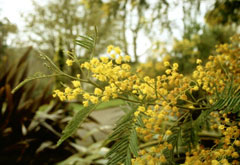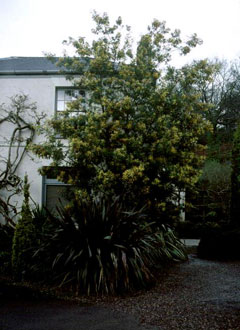 |
|
(c) ken Fern, Plants For A Future 2010 |
 |
| (c) ken Fern, Plants For A Future 2010 |
Translate this page:
Summary
Physical Characteristics

 Acacia_dealbata is an evergreen Tree growing to 25 m (82ft) by 8 m (26ft) at a fast rate.
Acacia_dealbata is an evergreen Tree growing to 25 m (82ft) by 8 m (26ft) at a fast rate.
See above for USDA hardiness. It is hardy to UK zone 8. It is in leaf all year, in flower from January to February. The species is hermaphrodite (has both male and female organs).
It can fix Nitrogen.
Suitable for: light (sandy) and medium (loamy) soils and prefers well-drained soil. Suitable pH: mildly acid and neutral soils. It cannot grow in the shade. It prefers dry or moist soil and can tolerate drought.
UK Hardiness Map
US Hardiness Map
Synonyms
A. decurrens dealbata.
Plant Habitats
Edible Uses
Flowers - cooked[144]. Rich in pollen, they are often used in fritters. A gum that exudes naturally from the trunk is edible and is used as a substitute for Gum Arabic[46]. It is very soluble in water and viscous[46, 153], but is of low quality[64]. Larger quantities can be obtained by tapping the trunk[64]. Some species produce a gum that is dark and is liable to be astringent and distasteful, but others produce a light gum and this is sweet and pleasant. It can be sucked like candy or soaked in water to make a jelly.[193]. The gum can be warmed when it becomes soft and chewable[193].
References More on Edible Uses
Medicinal Uses
Plants For A Future can not take any responsibility for any adverse effects from the use of plants. Always seek advice from a professional before using a plant medicinally.
None known
References More on Medicinal Uses
The Bookshop: Edible Plant Books
Our Latest books on Perennial Plants For Food Forests and Permaculture Gardens in paperback or digital formats.

Edible Tropical Plants
Food Forest Plants for Hotter Conditions: 250+ Plants For Tropical Food Forests & Permaculture Gardens.
More

Edible Temperate Plants
Plants for Your Food Forest: 500 Plants for Temperate Food Forests & Permaculture Gardens.
More

More Books
PFAF have eight books available in paperback and digital formats. Browse the shop for more information.
Shop Now
Other Uses
A yellow dye is obtained from the flowers[168]. A green dye is obtained from the seed pods[168]. The extensive root system of this plant helps to prevent soil erosion[200]. Tannin is obtained from the bark[61, 171]. On a 10% moisture basis, the bark contains 19.1% tannin[223].
Special Uses
References More on Other Uses
Cultivation details
Prefers a sandy loam and a very sunny position sheltered from strong winds[1, 11]. Succeeds in any good garden soil that is lime-free[11]. Plants become chlorotic on limey soils[200]. They grow well in a hot dry position[166], and are very drought tolerant[245]. Fast growing[88]. Although it prefers a well-drained soil, the plant is tolerant of both drought and wet conditions[260]. Hardy to about -10°c, this species succeeds outdoors in the milder areas of Britain[11, 184], growing well in Cornwall[49, 59]. If it is cut down by frosts it usually resprouts from the base to form a thicket of slender stems[166]. It can be trained and grown against a sunny wall[202]. Plants require hot, sunny summers if they are to ripen their wood fully and flower freely. In Britain they tend to do best when grown in coastal gardens in a sunny, sheltered position that is protected from the wind[11]. This species is closely allied to A. decurrens[11]. Old specimens sucker very freely, often at considerable distances from the parent tree[200]. Plants can be coppiced[134]. A very ornamental tree[1], there are some named varieties[260]. The species is cultivated in S. Europe for ornament, timber and soil stabilization[50]. The flowers are very attractive and are often sold in florists[11, 61]. The violet-like perfume of the flowers can be quite intoxicating on a calm day[245]. This species has a symbiotic relationship with certain soil bacteria, these bacteria form nodules on the roots and fix atmospheric nitrogen. Some of this nitrogen is utilized by the growing plant but some can also be used by other plants growing nearby[200].
References Carbon Farming Information and Carbon Sequestration Information
Temperature Converter
Type a value in the Celsius field to convert the value to Fahrenheit:
Fahrenheit:
The PFAF Bookshop
Plants For A Future have a number of books available in paperback and digital form. Book titles include Edible Plants, Edible Perennials, Edible Trees,Edible Shrubs, Woodland Gardening, and Temperate Food Forest Plants. Our new book is Food Forest Plants For Hotter Conditions (Tropical and Sub-Tropical).
Shop Now
Plant Propagation
Seed - best sown as soon as it is ripe in a sunny position in a warm greenhouse[1]. Stored seed should be scarified, pre-soaked for 12 hours in warm water and then sown in a warm greenhouse in March. The seed germinates in 3 - 4 weeks at 25°c[133]. As soon as the seedlings are large enough to handle, prick them out into individual pots and grow them on in a sunny position in the greenhouse for their first winter. Plant them out in late spring or early summer, after the last expected frosts, and consider giving them some protection from the cold for their first winter outdoors. Cuttings of half-ripe wood with a heel, July/August in individual pots in a frame[78]. Overwinter in a greenhouse for the first winter and plant out in their permanent positions in late spring or early summer. Fair percentage[78].
Other Names
If available other names are mentioned here
Native Range
AUSTRALASIA: Australia, Tasmania, New South Wales (east & south), Victoria, Australian Capital Territory,
Weed Potential
Right plant wrong place. We are currently updating this section.
Please note that a plant may be invasive in one area but may not in your area so it’s worth checking.
Conservation Status
IUCN Red List of Threatened Plants Status :

Growth: S = slow M = medium F = fast. Soil: L = light (sandy) M = medium H = heavy (clay). pH: A = acid N = neutral B = basic (alkaline). Shade: F = full shade S = semi-shade N = no shade. Moisture: D = dry M = Moist We = wet Wa = water.
Expert comment
Author
Link.
Botanical References
11154200
Links / References
For a list of references used on this page please go here
Readers comment